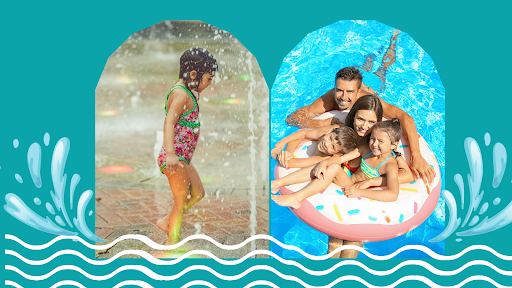Splash Pad Safety: What Parents Need to Know
Keep splash pad visits safe and fun with key tips for parents and kids. Know the rules, avoid risks, and prepare before heading out.

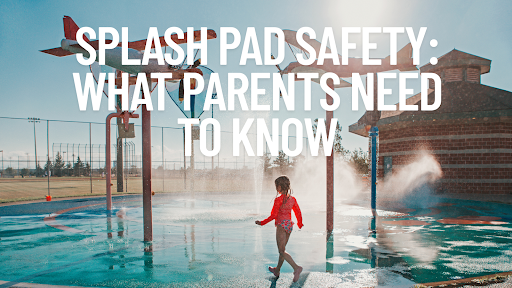
Splash pads are popping up in parks, playgrounds, and neighborhoods across the country—and kids can’t get enough of them. With colorful sprays, ground jets, and zero standing water, they’re designed for safe, active play.
But just because there’s no deep end doesn’t mean there aren’t risks. Before you head out, here’s what every parent should know about keeping splash pad visits safe and fun.
What Is a Splash Pad?
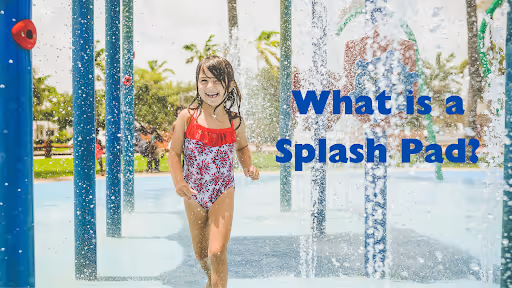
A splash pad is an outdoor play area equipped with water sprays, fountains, and nozzles that shoot water upwards from the ground. Unlike pools, splash pads do not have standing water, making them a safer alternative for children of all ages.
These areas typically utilize ground-based spray nozzles in various configurations and often feature recirculating pumps with low water flow to provide a continuous, safe water source for kids to cool off and enjoy.
Benefits of Splash Pads
1. Safer Than Pools
Splash pads don’t have standing water, which greatly reduces the risk of drowning. This makes them a safer choice for toddlers and younger kids who may not know how to swim.
Parents can feel more at ease while still keeping a close eye on their children.
2. Encourages Physical Activity
Running through water jets, dodging sprays, and jumping between fountains keeps kids moving. These actions help develop gross motor skills, balance, and coordination—all while they’re just having fun.
3. Supports Sensory Development
The splash pad experience activates multiple senses. Kids hear the water, feel different temperatures, and move across a range of textured surfaces.
This kind of play supports sensory processing and helps children understand how their bodies react to their surroundings.
4. Inclusive for All Abilities
Many splash pads are built with accessibility in mind. Flat surfaces, wide-open spaces, and water features at various heights make it easier for children with physical disabilities to participate.
Caregivers can also stay close without needing to get into the water.
5. Convenient for Families
Splash pads are usually located in public parks or community centers and are often free to use. They don’t require swim gear or swimming lessons, making spontaneous play more doable.
And since many are shaded or next to picnic areas, families can enjoy a full day out with minimal planning.
Safety Tips for a Worry-Free Splash Pad Visit
Safety starts with awareness and preparation. Here are some streamlined guidelines to ensure a safe splash pad experience:
What Parents Should Do at the Splash Pad
Splash pads may feel low-risk, but accidents and illness can still happen. Here are five simple ways parents can help keep the experience safe, clean, and fun for everyone:
1. Supervise Actively
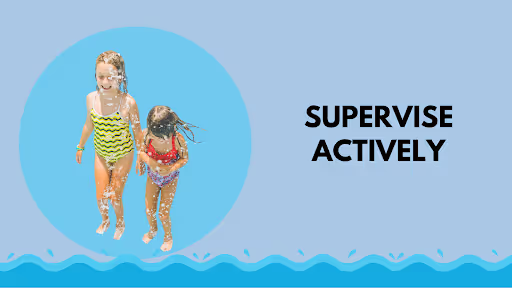
Always keep your eyes on your kids, no exceptions. Even if a lifeguard is on duty, your presence and focus matter most.
Supervision should be active and distraction-free. Accidents can happen quickly, even in shallow water.
2. Take Regular Bathroom Breaks
Plan bathroom breaks at least once an hour. For kids still in diapers, check and change them frequently, even with swim diapers.
This isn’t just about your child’s comfort; it helps prevent contamination and keeps the splash pad safe and clean for everyone.
3. Choose Water Shoes
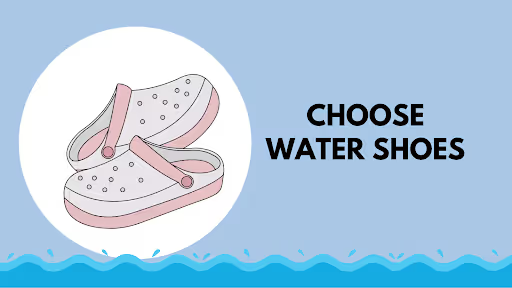
Water shoes are more than a fashion choice, and they offer traction on slippery surfaces, protect from hot pavement, and reduce contact with bacteria or sharp debris. They’re especially useful on textured concrete and wet surfaces that can lead to slips or scrapes.
4. Keep Sick Kids at Home
If your child has a fever, diarrhea, or has recently thrown up, skip the splash pad. Even if the water looks clean, splash pads often recycle water, which can spread illness quickly.
Waiting until your child is fully well protects other families, too.
5. Be Prepared with Safety Skills

Take the time to learn CPR and basic water rescue techniques. While splash pads are generally safer than pools, emergencies can still happen.
Being ready to act, even while waiting for help, could prevent a serious injury or save a life.
Splash Pad Rules for Kids
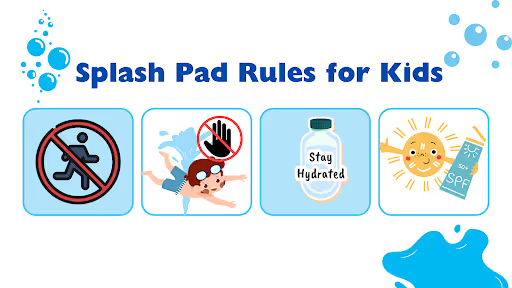
Before your child runs into the water, take a moment to review a few simple safety rules. Here are some easy ways kids can help keep splash pad play safe and fun for everyone:
1. Don’t Swallow the Water
Splash pad water isn’t clean enough to drink, even if it looks clear. It may carry germs that can cause upset stomachs, diarrhea, vomiting, or even ear and eye infections.
Remind your child to keep their mouth closed while playing and never treat the spray like a drinking fountain.
2. Stay Off the Water Jets
The jets are fun to watch and run through, but they aren’t seats or footrests. Sitting or standing on them can rinse germs into the water system, which then sprays onto everyone.
Teach your child to leave the jets alone so the water stays cleaner for all the kids playing.
3. No Running or Rough Play
Splash pads get slippery fast. Running, pushing, or trying to block the water can lead to bumps, bruises, or worse.
Encourage your child to walk, take turns, and respect other kids' space. Safe play keeps the fun going without anyone getting hurt.
4. Use Sun Protection
Even in the water, sunburn is a real risk. Apply a broad-spectrum, water-resistant sunscreen with SPF 30 or higher for at least 20 minutes before heading out.
Reapply every two hours or more often if your child is drying off. Hats, sunglasses, and UV-protective shirts are great extras to shield sensitive skin.
5. Keep Drinking Water
Being in water can trick kids into thinking they’re not thirsty, but they are. Heat and movement mean their bodies are still losing fluids.
Remind them to stop for water breaks every 20 to 30 minutes. Even a few sips help prevent fatigue, dizziness, and dehydration.
Bottom Line
Splash pads can provide hours of safe, fun, and refreshing play, but they take careful preparation and supervision. By following these guidelines, parents can ensure that their children enjoy splash pads while minimizing risks.
For safe, high-quality splash pad equipment and site furnishings, Park N Play is a trusted choice. Contact us to learn more about creating a safe and fun splash pad for your community.


